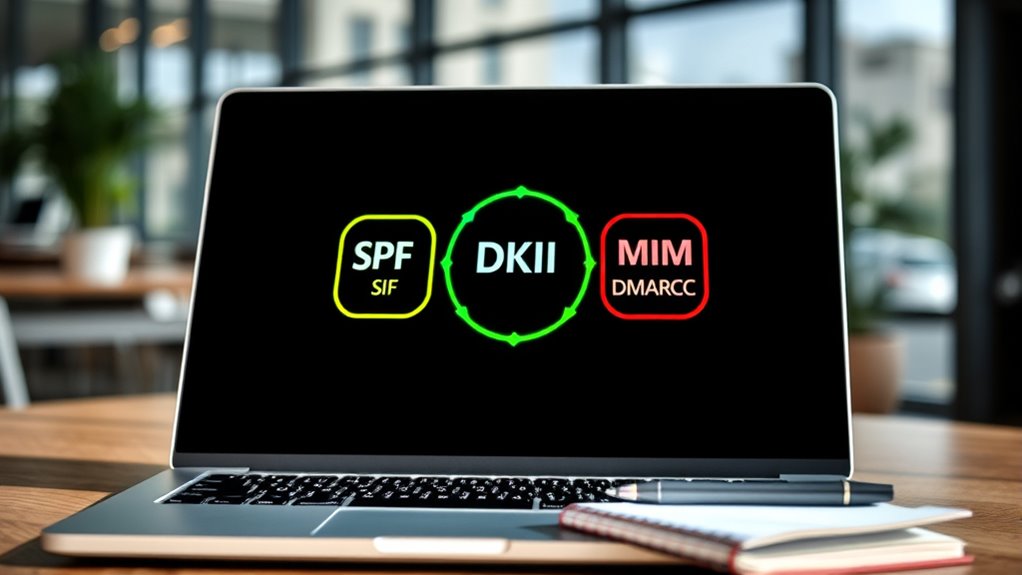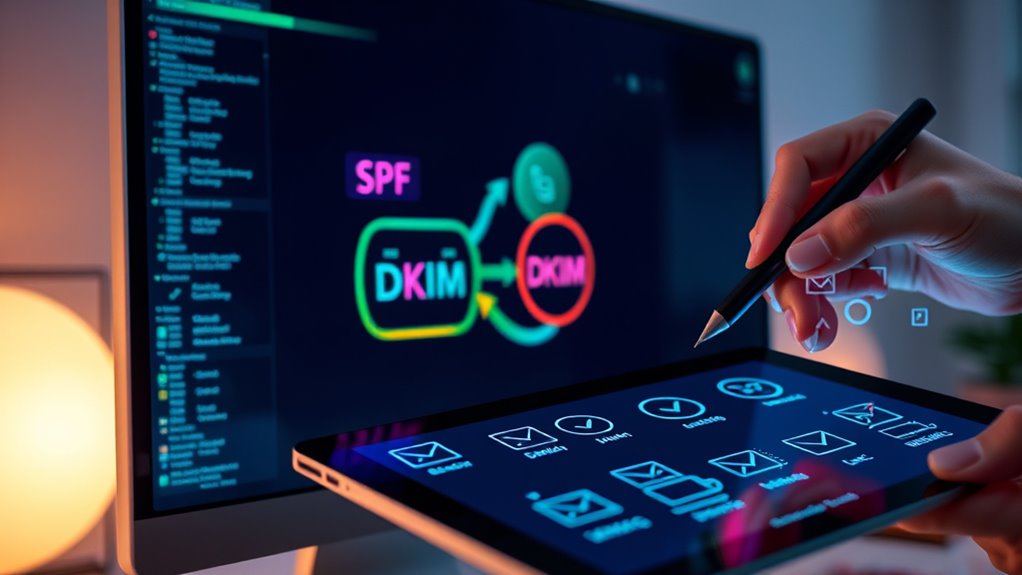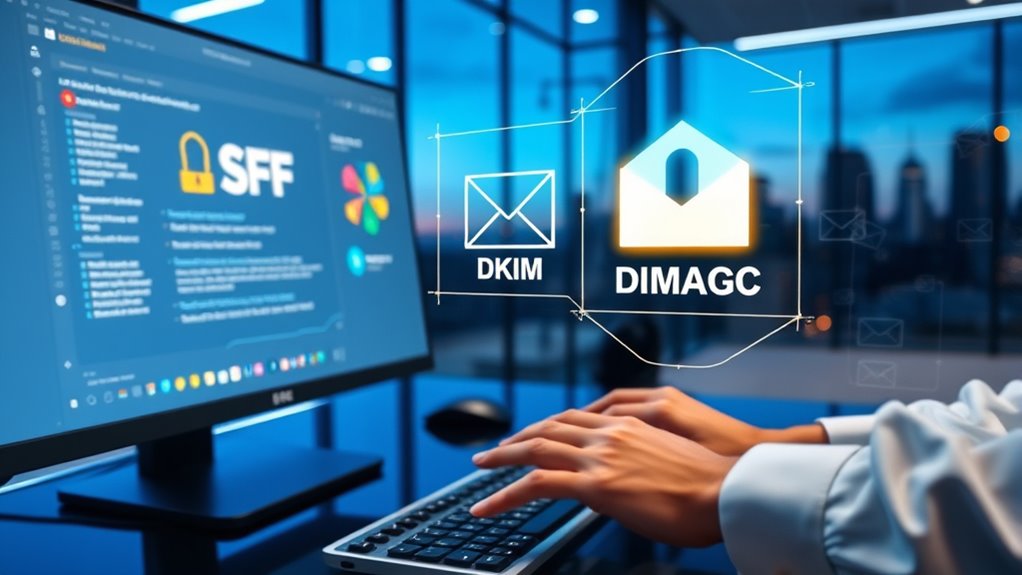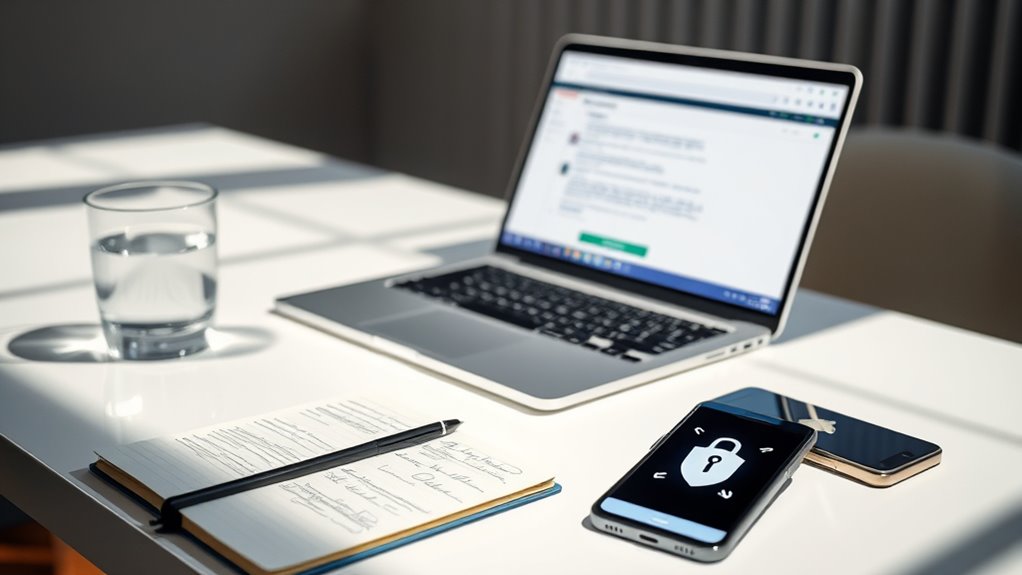Understanding SPF, DKIM, and DMARC helps you verify who’s sending your emails and guarantee they haven’t been tampered with. SPF checks if the email comes from authorized servers, DKIM adds a digital signature to confirm the content remains unchanged, and DMARC combines both to decide how to handle suspicious messages. Proper setup improves your email’s trustworthiness and delivery. Stick with us to learn how you can strengthen your email security and reputation.
Key Takeaways
- SPF, DKIM, and DMARC are email protocols that verify the sender’s identity and protect against impersonation and spoofing.
- SPF checks if an email is sent from authorized servers listed in the domain’s DNS records.
- DKIM attaches a digital signature to ensure the email content isn’t tampered with during transit.
- DMARC combines SPF and DKIM to enforce policies and improve email security and trustworthiness.
- Proper setup of these protocols enhances email deliverability, reduces spam, and prevents phishing attacks.
What Is Email Authentication and Why Is It Important?

Email authentication is a essential security measure that verifies whether an email truly comes from the sender it claims to be from. This process helps protect your email privacy by ensuring that only legitimate messages reach your inbox. Without proper authentication, malicious actors can impersonate trusted senders, compromising your security and privacy. Additionally, email authentication plays a key role in spam prevention. It helps email servers identify and block unwanted or harmful messages before they reach you. By implementing authentication protocols like SPF, DKIM, and DMARC, senders can prove their legitimacy, reducing the risk of phishing attacks and scams. Moreover, understanding the role of creative practice can help organizations develop more innovative and effective email security strategies. In short, email authentication is essential for maintaining a safe, trustworthy email environment and safeguarding your sensitive information.
How Does SPF Verify Who Can Send Your Emails?

Have you ever wondered how servers determine which messages are truly from a trusted sender? That’s where SPF, or Sender Policy Framework, comes in. SPF helps prevent email spoofing by letting you specify which mail servers are authorized to send emails on your domain’s behalf. When someone receives your email, their server checks your SPF record to verify if the sending server is permitted. If it isn’t, the message might be flagged as suspicious or rejected altogether. This process improves spam filtering and reduces the chances of your domain being used for malicious activities. By setting up SPF records correctly, you create a clear trust signal for receiving servers, making it harder for bad actors to impersonate you and ensuring your legitimate emails reach your recipients’ inboxes. Proper email authentication protocols are essential for maintaining email security and trust.
The Role of DKIM in Ensuring Email Content Isn’t Altered

While SPF verifies who can send your emails, DKIM guarantees that the content of those emails remains unchanged during transit. It does this by attaching a digital signature to your message, which recipients can verify using your public key. This process helps maintain email content integrity, ensuring that no one has tampered with your message along the way. DKIM acts as a message alteration prevention tool, providing confidence that the email you send is exactly what your recipient receives. If someone tries to modify the email, the signature becomes invalid, alerting the recipient to potential tampering. By implementing DKIM, you help protect your brand’s reputation and ensure your messages stay authentic and trustworthy. Additionally, understanding the importance of email authentication protocols can further enhance your email security measures.
Understanding DMARC and How It Combines SPF and DKIM

Understanding DMARC is essential because it provides a unified framework that leverages both SPF and DKIM to protect your domain from email spoofing. By doing so, it strengthens your email security and helps prevent phishing attacks. DMARC works by:
- Checking if an incoming email aligns with your SPF and DKIM policies
- Confirming whether the email genuinely originates from your domain
- Deciding how to handle emails that fail these checks, such as rejecting or quarantining them
This combined approach makes it harder for attackers to impersonate your domain and tricks recipients into revealing sensitive information. Implementing DMARC boosts phishing prevention efforts and ensures only legitimate emails reach your audience, safeguarding your reputation and reducing the risk of email spoofing. Additionally, understanding Practical Support can help organizations develop effective strategies for implementing these security measures.
How Email Providers Use These Checks to Protect Your Inbox

Email providers rely on DMARC, SPF, and DKIM checks to filter incoming messages and protect your inbox. These protocols help prevent email spoofing, where scammers impersonate legitimate senders. When a message arrives, your provider verifies its authenticity through these checks, filtering out malicious or suspicious emails before they reach you. Here’s what they do:
| Check Type | Purpose |
|---|---|
| SPF | Confirms sender’s IP matches authorized servers |
| DKIM | Validates message integrity and sender identity |
| DMARC | Enforces policies against spoofed emails |
| Spam Filtering | Blocks unsolicited or harmful messages |
Additionally, these protocols work together to maintain the overall email security of your inbox.
Setting Up SPF, DKIM, and DMARC for Your Own Domain

To set up SPF, DKIM, and DMARC, you need to verify that you own your domain and then configure the correct DNS records. These steps help prove your emails are legitimate and prevent spoofing. Once you’ve made the changes, test your email authentication to guarantee everything works properly. Incorporating cultural breakfast traditions can also inspire innovative ideas for your email campaigns.
Verify Domain Ownership
Verifying domain ownership is a crucial step in setting up your email authentication system. This process confirms you control the domain you’re securing with SPF, DKIM, and DMARC. To do ownership validation, you typically:
- Receive a unique verification code or token from your email provider.
- Add a specific record to your domain’s DNS settings.
- Confirm the record is live through your provider’s verification tool.
- Proper configuration ensures your domain is recognized as legitimate for email security purposes, which is essential for effective email authentication.
This ensures your domain is correctly linked to your email setup. Without proper domain verification, your email system isn’t fully authorized, risking delivery issues. Completing these steps proves your ownership, making your domain more trustworthy and improving your email deliverability.
Configure DNS Records
Once you’ve confirmed domain ownership, the next step is to properly configure your DNS records to authenticate your email setup. This involves adding SPF, DKIM, and DMARC records to your DNS settings. These records help establish trust, improving email encryption and ensuring that your messages aren’t marked as spam. SPF specifies which mail servers are authorized to send on your behalf, while DKIM adds a digital signature for verification. DMARC tells receiving servers how to handle unauthenticated emails, further reducing spam filtering issues. To do this, log into your DNS provider’s dashboard, locate your DNS records, and add the necessary TXT records for SPF, DKIM, and DMARC. Proper configuration is essential for email security and deliverability, and using vetted email protocols can significantly reduce the risk of phishing and spoofing attacks.
Test Email Authentication
After configuring your DNS records, it’s crucial to test your email authentication setup to make sure everything works correctly. Testing helps prevent email spoofing and improves spam filtering. Here’s what you should do:
- Use online tools like MXToolbox or DMARC Analyzer to check your SPF, DKIM, and DMARC records.
- Send test emails to check if they pass authentication and aren’t flagged as spam.
- Review the reports from your email provider to identify any issues with your setup.
Common Problems and How to Troubleshoot Email Authentication Issues

Are email authentication issues causing delivery failures or warning messages? If so, you might be dealing with problems like misconfigured SPF, DKIM, or DMARC records. These issues can allow email spoofing, where attackers send messages that appear legitimate, increasing the risk of phishing attacks. To troubleshoot, first check if your DNS records are correctly set up and published. Use online tools to verify your SPF, DKIM, and DMARC configurations. Look for errors or mismatches that could cause your emails to be flagged or rejected. Also, review your email headers for signs of spoofing or suspicious activity. Correcting record errors and ensuring alignment across your authentication methods will reduce false positives, improve deliverability, and help prevent your domain from being exploited in phishing schemes. Additionally, understanding the role of email authentication protocols can help you better secure your domain and maintain trust with your recipients.
The Benefits of Proper Email Authentication for Businesses and Users

When you use proper email authentication, your brand gains trust because recipients see your messages as legitimate. It also helps protect you and your users from phishing attacks that can compromise sensitive information. Overall, authenticating your emails strengthens your reputation and keeps everyone safer. Ensuring your email system includes security measures like SPF, DKIM, and DMARC is essential for maintaining trust and safeguarding your digital communications.
Enhanced Brand Trust
Have you ever wondered why some brands immediately gain your trust while others raise suspicions? Proper email authentication plays a key role in building that trust. When you implement SPF, DKIM, and DMARC, you reduce email spoofing, making it harder for scammers to pretend to be your brand. This reassures your customers that your messages are authentic. Additionally, strong authentication improves spam filtering, ensuring your legitimate emails reach inboxes instead of spam folders.
Here’s how it benefits your brand:
- Protects your reputation by preventing impersonation.
- Increases customer confidence in your communications.
- Enhances deliverability rates, ensuring your messages are seen.
Ultimately, proper authentication fosters trust and strengthens your brand’s credibility.
Reduced Phishing Risks
Ever wonder how proper email authentication reduces the risk of falling victim to phishing attacks? When you implement SPF, DKIM, and DMARC, you help email systems verify that messages truly come from trusted sources. This prevents cybercriminals from spoofing your domain to send malicious emails. As a result, spam filters become more effective at catching fake messages before they reach your inbox. Additionally, combining email authentication with email encryption ensures sensitive information stays secure, even if a phishing attempt slips through. These layers of protection make it harder for attackers to deceive you, reducing your chances of falling for scams. Ultimately, proper email authentication safeguards your business and personal data by minimizing phishing risks and strengthening your overall email security.
Future Trends in Email Security and Authentication

As email threats continue to evolve, future trends in email security and authentication focus on leveraging advanced technologies to stay ahead of cybercriminals. You can expect improvements in email encryption, which ensures your messages stay private even if intercepted. Enhanced spam filtering algorithms will better identify and block malicious emails before they reach your inbox. Additionally, new authentication methods will integrate AI-driven analysis to detect sophisticated phishing attempts. Here are some key developments:
- AI-powered spam filtering for more accurate threat detection
- End-to-end email encryption becoming standard across platforms
- Adaptive authentication that learns and responds to emerging threats
These trends will help you maintain a safer, more secure email environment as cyber threats grow more complex.
Frequently Asked Questions
Can Email Authentication Prevent All Forms of Email Fraud?
Email authentication helps prevent many scams, but it can’t stop all fraud. While SPF, DKIM, and DMARC can block phishing scams and malware delivery from unauthorized senders, savvy attackers may still find ways around them. You need to stay vigilant, recognize suspicious emails, and use additional security measures to protect yourself. Relying solely on email authentication isn’t enough; a all-encompassing approach keeps you safer from evolving threats.
How Do I Know if My Domain’S Email Is Properly Authenticated?
Think of your domain like a trusted ship sailing the digital seas. To confirm it’s properly authenticated, you should run email validation and domain verification checks. Use tools or DNS records to see if SPF, DKIM, and DMARC are correctly set up. If these records are in place and align with your email practices, your domain’s email is likely properly authenticated, helping protect against spoofing and phishing.
Are SPF, DKIM, and DMARC Necessary for Personal Email Accounts?
You might wonder if SPF, DKIM, and DMARC are necessary for personal email accounts. While they mainly help with email privacy and prevent spam filtering issues, setting them up isn’t always vital for individual use. However, enabling these protocols can boost your email security, reduce spam, and ensure your messages aren’t marked as phishing. If you care about email integrity and privacy, it’s worth configuring these standards, even for personal accounts.
What Are the Common Signs of Email Authentication Failure?
Imagine your email’s playing hide and seek, but instead of fun, it’s bouncing back like a bad check. Signs of auth failure include email bounce notices, suspicious links, or messages that just don’t feel right. You might spot odd sender addresses or unexpected requests. These clues signal your email’s failed authentication, making it vulnerable to spoofing or phishing. Stay alert, or your messages might just vanish into the digital abyss.
How Often Should I Review or Update My Email Authentication Settings?
You should review and update your email authentication settings at least every six months to maintain strong email security and guarantee reliable account verification. Regular checks help catch any misconfigurations or updates needed due to changes in your email provider or domain. Staying proactive prevents email spoofing and phishing attacks, helping protect your account integrity and maintain trust with your contacts. Consistent review keeps your email defenses robust and effective.
Conclusion
By setting up SPF, DKIM, and DMARC, you’re building a fortress around your emails—guarding your reputation like a shield and ensuring your messages reach trusted inboxes. Without these protections, your emails are like fragile paper boats in a storm, easily capsized by fraud and spam. Embrace proper authentication, and you’ll navigate the digital seas with confidence, turning potential chaos into a calm, secure harbor for your messages and your trust.
Natali – Editor in Chief (Strategy and Mastery, AI Expert) Natali, our Editor in Chief, is the driving force behind our content’s strategic direction. With a keen eye for detail and a deep understanding of market trends, Natali ensures that our content is top-notch and strategically aligned with our client’s goals. Her expertise in AI helps to seamlessly integrate advanced technology into our marketing strategies, pushing the boundaries of conventional marketing.




![Personalization Basics: Beyond "Hello [Name]" in Your Emails 24 advanced email personalization techniques](https://leftbrainmarketing.net/wp-content/uploads/2025/11/advanced_email_personalization_techniques_7bop8-560x300.jpg)





